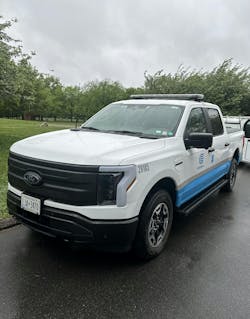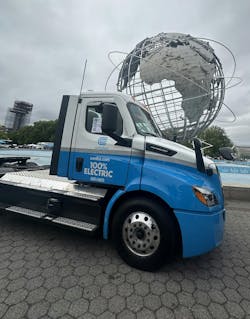Con Edison Charges Forward on EV Infrastructure
Key Highlights
- Con Edison aims to electrify 100% of its light-duty fleet by 2035, with an interim target of 80% by 2030, supporting New York’s clean energy goals.
- The utility has deployed over 165 charging stations and plans to expand to more than 300 by 2025, with a long-term goal of 2,000 stations by 2030.
- Strategic planning includes site assessments, load analysis, and infrastructure design to ensure cost-effective and scalable charging solutions.
- Con Edison uses modular, upgradeable charging stations with smart technology to enhance flexibility, maintenance, and future compatibility.
As the largest energy provider in New York state, Consolidated Edison Inc. has committed to supporting the clean energy transition in numerous ways — including taking steps to fully electrify its fleet vehicles. The utility serves 10 million people who live in New York City as well as Orange, Rockland and Westchester Counties.
“Our goal is to electrify our fleet of light-duty vehicles by 2035 with an interim target of 80% by 2030,” said Fortunato Gulino, chief automotive engineer at Consolidated Edison (Con Edison). “Going forward, 100% of our light-duty fleets will be electrified vehicles.”
Con Edison has taken some big steps toward its electrification goals already. The utility was an early adopter of the industry’s first all-electric bucket truck when it purchased a zero-emissions 55-ft (17-m) aerial device from Terex Utilities in 2022. Con Edison’s fleet also consists of electric and hybrid light-duty vehicles, including a Chevy Bolt EV and EUV, Chevy Blazer and Silverado EV, Ford Lightning and Ford Mustang Mach-E. The utility also has deployed plug-in hybrid electric vehicles (PHEVs) like the Toyota Prius and RAV 4 Prime, Kia Sportage and Dodge Hornet R/T. The Freightliner eCascadia was the latest addition to Con Edison’s fleet in 2024.
As its fleet becomes more electrified, access to charging stations has become imperative. “In addition to our service area, we also support neighboring utilities with mutual aid and other nonemergency projects. Charging access for our fleet was identified as a definite need,” Gulino explained.
Con Edison has more than 20 properties throughout its service area in New York, with 165 charging stations and 205 charging plugs. The utility expects to grow this to more than 300 charging plugs by the end of 2025. By 2030, its goal is to have approximately 2000 charging stations across all its properties. With such an aggressive target, the utility has learned several best practices along the way that are helping it to meet this goal.
Calculated Planning
Because of its vast footprint and huge undertaking ahead, Con Edison began a deliberate planning process that involved constant communication among departments and engaging with employees upfront to understand charging needs and preferences. “Toward the beginning of our planning process, we started by defining our end goal and worked backwards from there,” said Shannon Solomon, electric vehicle strategic initiative specialist at Con Edison.
“A part of this was identifying the fleet and equipment we have at each site and defining what the future was going to look like,” Solomon explained. “That way we have an initial understanding of the charger quantities that will be needed at each location. We also worked on our charging infrastructure plan from a future proofing standpoint. We want the infrastructure to have ample capacity to allow for future charging stations to be installed.”
Con Edison also planned for predominately Level 2 charging stations in addition to some direct-current (dc) fast charging stations at each major workout location. With the utility’s fleet typically living at a specific location, it made sense to have most of the charging infrastructure as Level 2. That way, the EVs could charge overnight but also have the ability to dc fast charge when needed.
“We also found that it’s important to standardize all of your electrical equipment and components — and how you design each facility,” Solomon added. “This helps with maintenance and the replacement of parts.”
Utilities should also identify what they want from the charging infrastructure: Is it just to charge the EVs or to also collect data? If collecting and reporting on data is a goal, its best to start with a charging manufacturer with good software.
As the process moved forward, it became apparent how important it was to have well-thought-out plans due to challenges that arose along the way. “We found that it can be quite a lengthy process to install electric vehicle supply equipment (EVSE),” said Gulino.
The process involves working with engineering to lay out the design plans. All the needed electrical equipment needs to be ordered and the installation plan needs to be developed, which includes tying everything in and activating the charging stations.
“When it comes time for the physical construction, you need to make sure you have the proper permits in place or that could cause significant delays,” Gulino added.
If a utility is in a more metropolitan area, like New York City, permits may be required. Also consider the actual site and whether other permits may be needed, such as with the U.S. Environmental Protection Agency.
Con Edison also dealt with delays because of long lead times on electrical components, such as switchgear, transformers and panel boards, due to supply chain constraints. “That’s why it’s very important to plan further out in advance and order equipment ahead of time, so delays aren’t as significant,” Solomon said.
Thorough Site Assessments
A thorough site assessment with a certified electrician should be conducted at each location to determine electrical capacity and potential upgrade needs. “The main part of this assessment is the load analysis, which determined how much load we were going to need at that facility to support the charging stations. After that, we looked at our existing load and identified what we needed to do to support future charging infrastructure,” Solomon recalled.
An assessment of the physical layout of each property was also conducted. Utilities should put chargers in areas that make the most sense, logistically speaking. “For example, we recommend that utilities place dc fast chargers in a more wide-open area and set them up like a fuel station, so that larger trucks have the ability to charge there with no issue,” said Solomon. “Utilities should also take into consideration the fast-charging cable length, as the dc fast chargers tend to have thicker, shorter cables.”
“We also found that it’s important to plan for charging locations that balance convenience with cost-effective installation,” Solomon explained.
Placing charging stations close to the service point of entry can decrease the amount of cable trenching and conduit links. The planned location should also take into account how operators will access the charger with their EV based on charging port locations.
“Our intent was to plan the install in the most cost-effective, logical and rational way when it came to the construction,” Solomon added.
Future Factors
As Con Edison continues forward with expanding its EV fleet and adding charging infrastructure, it looks at the scalability and capacity of each location. It is installing charging infrastructure with extra capacity to accommodate future growth and expansion. “If down the road we realize we need additional charging stations at a location, it will be purely installation and then connecting the station to the existing power supply,” Solomon noted.
Con Edison also considers the size of the vehicle and battery. “We want to make sure we install the correct chargers. We’re installing for higher-capacity level 2 chargers. Many in the industry uses 7.6 kW, but we’re installing 80-A, 19.2-kW chargers. This isn’t necessarily for the vehicles today but for the vehicles of the future,” Solomon explained. “Battery technology is ever changing, and manufacturers are shipping vehicles with bigger and bigger batteries.”
Another factor Con Edison keeps in mind is flexibility. The utility uses modular-type charging systems that can be easily upgraded or replaced as technology advances. The stations come configurable with either one or two charging plugs, based on the need. When constructed, the major components are kept separate from each other. That way, for example, if one plug gets damaged, it can be replaced without having to rip out the whole charging station and start over. In addition, if the electric industry shifts toward one type of plug, Con Edison’s modular design will enable it to swap out existing plugs.
Another important component to Con Edison’s charging station plans is using equipment with smart charging capabilities that have comprehensive charging management software. The telematics from this solution provides information and insights into energy usage, efficiency and charging optimization. “We can gather data on charging station use, including the number of charging sessions, length of each session and energy used per session,” Solomon shared. “We can also determine when most people are plugging in and how long people stay on the charger after they have completed charging.”
This enables Con Edison to optimize the charging station use, so it can get the most efficient use out of them. This includes continual employee communication and training as the telematics data comes in.
“Finally, we continue to follow industry trends and standards and diversifying our EVSE to ensure our infrastructure remains compatible with emerging technologies,” said Solomon.
About the Author
Sean Umland
Sean Umland ([email protected]) is manager of the electric vehicle strategic initiative at Con Edison. With over 12 years of expertise in fleet operations, Umland oversees the design, planning and installation of EV charging infrastructure for both Con Edison and Orange & Rockland Utility. He drives initiatives that align with the company’s clean energy goals for a more sustainable future.
Joe Caywood
Joe Caywood ([email protected]) is director of commercial operations at Terex Utilities. He currently leads marketing, product management, sales operations, technical support and warranties. Caywood has been with Terex for more than 22 years and served in a variety of leadership roles at both Terex Utilities and Genie.



